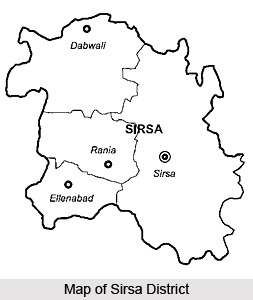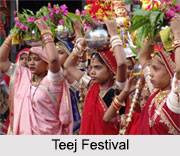 Sirsa District is one of the 21 administrative districts of Haryana with its headquarters at Sirsa town. This district lies between 29 degree 14 minutes and 30 degree north latitudes and 74 degree 29 minutes and 75 degree 18 minutes east longitudes, forming the extreme west corner of Haryana. Sirsa District is bounded by Faridkot District and Bathinda District of Punjab in the north and north east, by Ganganagar District of Rajasthan in the west and south and Hisar District in the east. Thus, it touches the interstate boundaries on three sides and is connected with one district of its own state only in the eastern side. People here mostly speak Bagri language.
Sirsa District is one of the 21 administrative districts of Haryana with its headquarters at Sirsa town. This district lies between 29 degree 14 minutes and 30 degree north latitudes and 74 degree 29 minutes and 75 degree 18 minutes east longitudes, forming the extreme west corner of Haryana. Sirsa District is bounded by Faridkot District and Bathinda District of Punjab in the north and north east, by Ganganagar District of Rajasthan in the west and south and Hisar District in the east. Thus, it touches the interstate boundaries on three sides and is connected with one district of its own state only in the eastern side. People here mostly speak Bagri language.
History of Sirsa District
History suggests a number of legends about the origin of the name of Sirsa town. Its ancient name was Sairishaka and from that it seems to have been distorted to Sirsa. According to local tradition, an unknown king named Saras founded the town in 7th century AD and built a fort here. The remains of an ancient fort can still be seen in the south-east of the present town. According to another tradition, the name has its origin from the sacred river Sarasvati which one flowed near it. During medieval period, the town was known as Sarsuti. It has been mentioned as Sarsuti by a number of medieval historians. The derivation of name Sirsa is also attributed to the abundance of sirish trees in the neighborhood of Sirsa which seems quite plausible for it finds some corroboration also in Panini and his commentator. In ancient period, Sirsa was also known as Sirsapattan. In 1975, Sirsa District was formed.
Geography of Sirsa District
Topographically, the land of Sirsa District can be classified in three distinct types from north to south and these are Haryana Plain, alluvial bed of Ghaggar River and Sand dune tract. Sirsa District has a relatively dry climate characterised with extreme temperatures and low rainfall. A seasonal year can be divided into winter season from November to March, summer season that lasts up to June, followed by Monsoon season from July to the mid of September and the transition period from mid September to October. Sirsa District is quite rich in flora and fauna and is inhabited by varied groups of animals.

Administration of Sirsa District
The Sub-Divisions of Sirsa District are Sirsa, Dabwali and Ellenabad. Further, administration of Sirsa District includes four tehsils namely Mandi Dabwali, Sirsa (with Kalan Wali and Nathusari Chopta as Sub-Tehsils), Rania and Ellenabad. There are seven community development blocks in Sirsa District and these are Baragudha, Mandi Dabwali, Ellenabad, Nathusary Chopta, Odhan, Rania and Sirsa.
Culture of Sirsa District
Culture of Sirsa District is vibrant and reflects the rich tradition of the district. The people in the district still continue to follow the old festivals and traditions of observing Amavasya and Purnmashi in Lunar Month. The most significant festivals celebrated here are Teej, Raksha Bandhan, Janmashtami, Dussehra, Diwali, Makar Sankranti, Vasant Panchami, Shivaratri, Holi, Id-ul-Fitr , Id ul Zuha, Muharram, Ramnavami and many more. All these festivals in the district as elsewhere are celebrated with full devotion and joy. Most of the fairs are of religious origin; however, they also exhibit a bit commercial colour as thousands of people participate. Moreover, a fair popularly known as Mela Ram Dev is held annually at this place. Another socio religious fair called Baisakhi fair is held at Sirsa town in the month of Baisakh.
Tourism in Sirsa District
Tourism in Sirsa District offers visits to several religious and historical sites. Some of the noteworthy attractions of Sirsa District are Dera Sacha Sauda, Radha Swami Satsang Ghar, Ram Dev Mandir, Hanuman Temple, Dera Jiwan Nagar, Dera Sufi Saint Baba Bhuman, Gurudwara Guru Gobind Singh, Dera Baba Sarsai Nath, Sikanderpur, Arnian Wali, Saint Baba Bihari Samadhi, Suchan, Mangiana and Tomb of Khawaja Pir. These places are worth seeing.
Sirsa is located at around 255 kms from Delhi and around 280 kms from Chandigarh.






